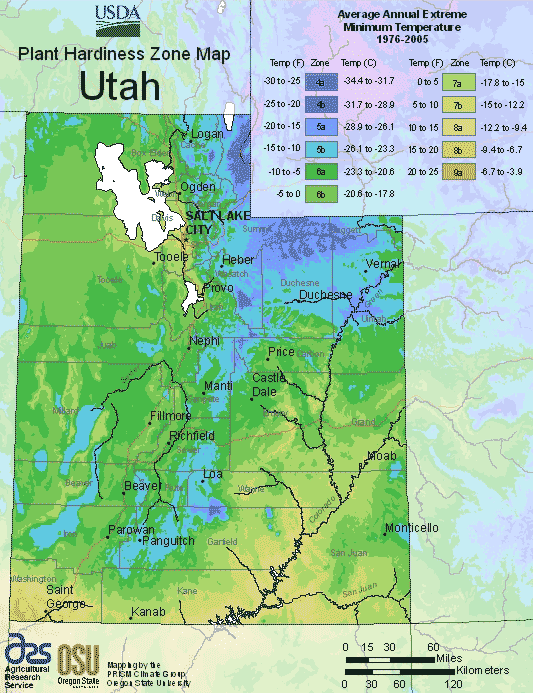The state’s planting zones range from Zone 4 in the higher mountainous regions to Zone 9 in the lower elevations

Table of Contents
Characteristics of Utah Planting Region
In Utah, the typical growing period is of moderate length, though it differs in different areas. Usually, it begins in mid-May and ends around October.
Challenges of Growing in Utah
Despite the extended growing season, there are numerous difficulties with gardening in Utah.
1. Unpredictable Weather
The weather in the state is very erratic and harsh. Wildfires, thunderstorms, landslides, winds, and more render the area a complete unknown when it comes to monitoring weather conditions. This makes it challenging to observe changes and be prepared for your garden.
2. Extreme Temperature Fluctuations
3. Dry Climate
Utah is familiar with droughts as a result of its arid climate and low annual precipitation. This can pose a problem for outdoor plant growth.
The Best Plants for Utah’s Planting Zone

Utah’s diverse landscapes and varying climates provide an exciting opportunity for gardening enthusiasts to cultivate a wide range of plants. The state’s planting zones range from Zone 4 in the higher mountainous regions to Zone 9 in the lower elevations, offering a unique combination of arid and mountainous conditions. By selecting the right plants that can thrive in Utah’s specific environment, gardeners can create a tapestry of beauty in their landscapes. Here are some of the best plants to grow in Utah’s planting zone:
- Utah Serviceberry (Amelanchier utahensis): As a native shrub, the Utah Serviceberry is well-suited to Utah’s diverse regions. It produces clusters of white flowers in spring, followed by small edible berries that attract wildlife and add interest to the garden.
- Penstemons (Penstemon spp.): Penstemons are native perennials that come in a variety of colors and shapes. These drought-tolerant flowers attract pollinators and add a splash of vibrant colors to Utah’s gardens.
- Rocky Mountain Juniper (Juniperus scopulorum): Rocky Mountain Juniper is a hardy evergreen tree that can thrive in Utah’s mountainous regions. Its distinctive blue-green foliage and attractive bark make it a valuable addition to the landscape.
- Red Yucca (Hesperaloe parviflora): Red Yucca is a succulent that thrives in Utah’s arid regions. Its tall flower spikes with coral-red blooms add a striking focal point to xeriscape gardens.
- Russian Sage (Perovskia atriplicifolia): Russian Sage is a popular choice for Utah gardens due to its drought tolerance and silvery foliage. The lavender-blue flowers attract pollinators and provide a beautiful contrast to other plants.
- Ponderosa Pine (Pinus ponderosa): Ponderosa Pine is a native evergreen tree that can withstand Utah’s drier conditions. Its large size and distinctive bark add a touch of majesty to the landscape.
- Agastache (Agastache spp.): Agastache, also known as Hummingbird Mint, is a favorite among pollinators. These aromatic perennials come in various colors and provide continuous blooms throughout the summer.
- Gambel Oak (Quercus gambelii): As a native deciduous tree, Gambel Oak thrives in Utah’s higher elevations. Its attractive foliage and ability to adapt to different soil types make it a valuable choice for home landscapes.
- Catmint (Nepeta spp.): Catmint is a low-maintenance perennial that is well-suited to Utah’s climate. Its delicate lavender-blue flowers and aromatic foliage add a soft and soothing element to the garden.
- Utah Agave (Agave utahensis): Utah Agave is a desert plant that thrives in Utah’s arid regions. Its striking rosette form and spiky leaves make it an eye-catching addition to rock gardens and xeriscape landscapes.
To ensure successful gardening in Utah, it’s crucial to consider the specific conditions of each region. In the drier areas, water-wise gardening practices, such as mulching and drip irrigation, can help conserve water and support drought-tolerant plants.
In colder mountainous regions, selecting cold-hardy plants that can withstand freezing temperatures is essential for their survival. Proper soil preparation, including adding organic matter and maintaining good drainage, is also vital for healthy plant growth.
By embracing the diversity of Utah’s planting zones and selecting the right plants for each area, gardening enthusiasts can craft a tapestry of beauty that celebrates the state’s distinct environments and enhances the appeal of their outdoor spaces.
FAQ
What is my growing zone in Utah?
In Utah, the planting zones range from 4 in the northeast to 8 in the southwest. Around Salt Lake City, Zone 5 plants and lower are suitable. Certain areas are able to accommodate Zone 6 and 7 plants and lower.
What planting zone is North Salt Lake Utah?
North Salt Lake, Utah falls into USDA Hardiness Zones 6b, 7a, and 7b.
What zone is slc in?
Salt Lake City, Utah is located within Hardiness Zones 5b-7b of the USDA.
What zone is Salt Lake City in for planting?
Salt Lake City, Utah is located in USDA Hardiness Zones 5b through 7b.
